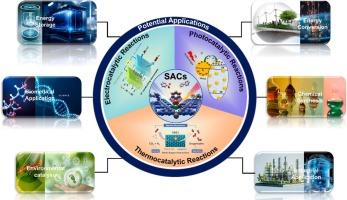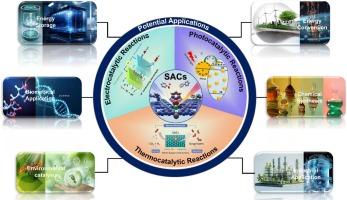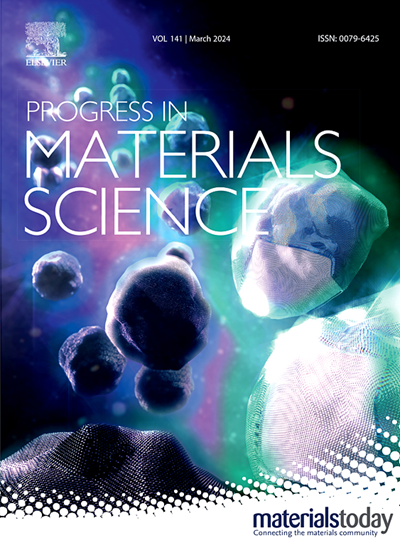Single atom horizons for shaping the future of catalysis and sustainability: the next frontiers in energy conversion and storage
IF 40
1区 材料科学
Q1 MATERIALS SCIENCE, MULTIDISCIPLINARY
引用次数: 0
Abstract
Single-atom catalysts have recently emerged as a revolutionary frontier in catalysis, energy production, and storage. Due to their compositional diversity, structural tunability, and modulated distinctive electronic properties, SACs pave significant promises for viable avenues toward a more sustainable future. Here, the discussion begins with the emergence of SACs, their synthesis techniques to regulate atomic dispersion, atomically-resolved advanced characterizations, probing different supports, and engineering strategies to boost stability and reactivity. This review as a key reference in this field comprises the mechanistic understanding of SACs in electrocatalysis, photocatalysis, and thermocatalysis for energy and environmental applications. We also discussed their transformative potential in H2 and O2 evolution reactions for water splitting, the reduction of O2, carbon dioxide, N2, and nitrate for electrocatalysis and photocatalysis, and their remarkable role in energy storage technologies, including metal-O2, lithium-sulfur, and metal-CO2 batteries. Additionally, we assess their efficiency in environmental remediation by removing harmful nitrogen oxides, various hydrogenation processes, catalytic oxidation, and CO2 hydrogenation, which sets this review apart from others. Despite the considerable progress, challenges persist in the scalability and commercial implementation of SACs. This comprehensive review significantly delivers valuable insights into the current advancement of SACs, highlighting their substantial potential and suggesting future research avenues that would enable next-generation technologies for energy conversion, storage, environmental sustainability, and various other functional applications.


塑造催化和可持续性未来的单原子视野:能量转换和存储的下一个前沿
近年来,单原子催化剂在催化、能源生产和储存方面出现了革命性的前沿。由于其组成的多样性、结构的可调性和调制的独特电子特性,SACs为实现更可持续的未来铺平了重要的道路。在这里,讨论从SACs的出现开始,它们的合成技术来调节原子分散,原子分辨高级表征,探测不同的支持,以及提高稳定性和反应性的工程策略。本文综述了SACs在电催化、光催化和热催化领域的应用机理,作为该领域的重要参考文献。我们还讨论了它们在H2和O2演化反应中的变革潜力,用于水分解,用于电催化和光催化的O2,二氧化碳,N2和硝酸盐的还原,以及它们在储能技术中的显着作用,包括金属-O2,锂-硫和金属- co2电池。此外,我们通过去除有害的氮氧化物、各种加氢过程、催化氧化和二氧化碳加氢来评估它们在环境修复中的效率,这使本综述与其他综述不同。尽管取得了相当大的进展,但sac的可伸缩性和商业实现方面仍然存在挑战。这篇全面的综述对sac的当前进展提供了有价值的见解,突出了它们的巨大潜力,并提出了未来的研究途径,这些研究途径将使下一代技术能够用于能量转换、存储、环境可持续性和各种其他功能应用。
本文章由计算机程序翻译,如有差异,请以英文原文为准。
求助全文
约1分钟内获得全文
求助全文
来源期刊

Progress in Materials Science
工程技术-材料科学:综合
CiteScore
59.60
自引率
0.80%
发文量
101
审稿时长
11.4 months
期刊介绍:
Progress in Materials Science is a journal that publishes authoritative and critical reviews of recent advances in the science of materials. The focus of the journal is on the fundamental aspects of materials science, particularly those concerning microstructure and nanostructure and their relationship to properties. Emphasis is also placed on the thermodynamics, kinetics, mechanisms, and modeling of processes within materials, as well as the understanding of material properties in engineering and other applications.
The journal welcomes reviews from authors who are active leaders in the field of materials science and have a strong scientific track record. Materials of interest include metallic, ceramic, polymeric, biological, medical, and composite materials in all forms.
Manuscripts submitted to Progress in Materials Science are generally longer than those found in other research journals. While the focus is on invited reviews, interested authors may submit a proposal for consideration. Non-invited manuscripts are required to be preceded by the submission of a proposal. Authors publishing in Progress in Materials Science have the option to publish their research via subscription or open access. Open access publication requires the author or research funder to meet a publication fee (APC).
Abstracting and indexing services for Progress in Materials Science include Current Contents, Science Citation Index Expanded, Materials Science Citation Index, Chemical Abstracts, Engineering Index, INSPEC, and Scopus.
 求助内容:
求助内容: 应助结果提醒方式:
应助结果提醒方式:


